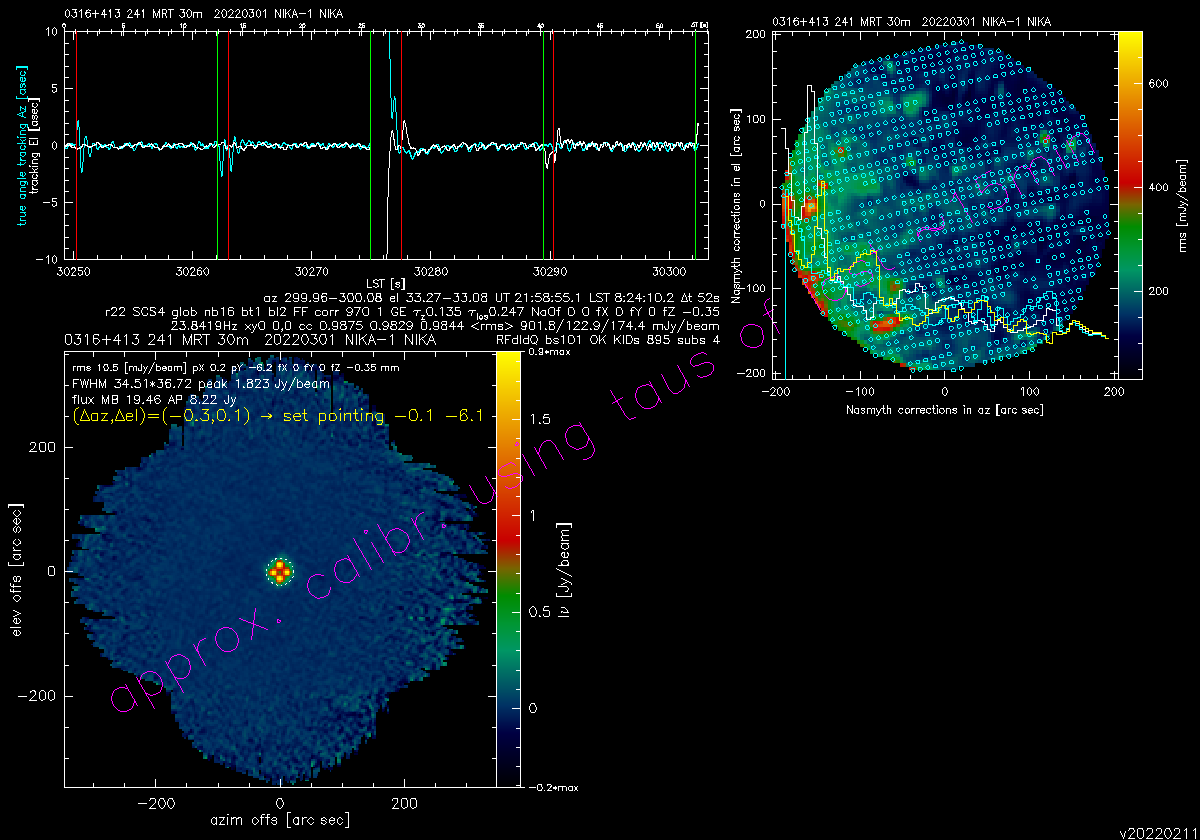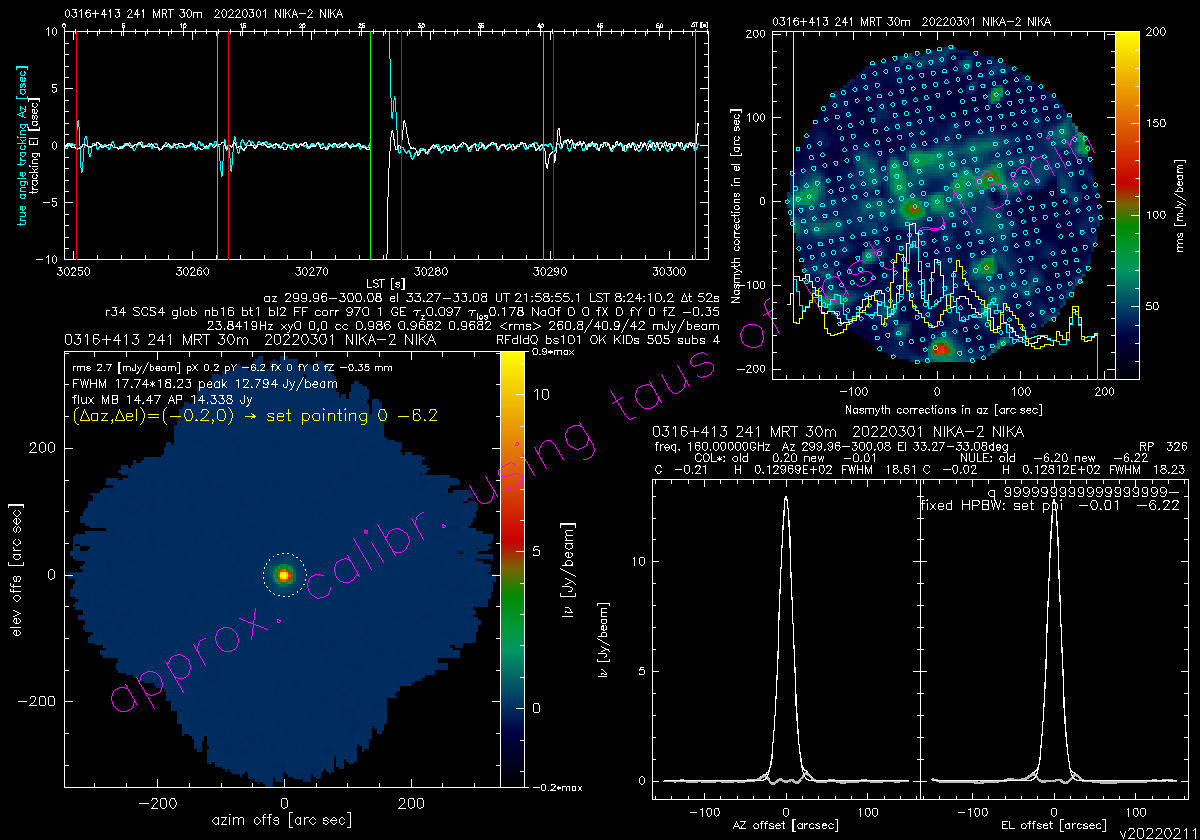Daily Reports
Contents
Mar 1st, Tuesday
22:00-03:00; Frédéric (on-site) & Hélène (remote): [IM: We start at 22:00, after maintenance and the technical time slot T06-21 that was dedicated to measurements for the telescope efficiencies. Initial NIKA2 tuning looks fine with 29/7/50 bad KIDs for A1/A2/A3, respectively. However, initial pointing and focus yields a strange effect only for 1mm data: 4 images of the pointing source in a cross-like pattern. This was not visible for 2mm data. We repeat the pointing to another source and get the same effect. Then we try to re-start everything: put mirrors back to EMIR setup and then back to NIKA2 setup and restart DAQ and retune KIDs. After these steps the pattern at 1mm data goes away. We have good beam size and shape (~17.7" @ 2mm and ~12" @ 1mm) as well as atmospheric fluctuations are very low (~0.5 Jy/beam). After a calib_1scan [20220301s246] and a beam map [20220301s247] on the quasar 0316+413, we start with observations for the IMEGIN LP (160-16).] Earlier that evening the staff performed some tests to characterize the efficiency of the telescope. The AoD started tuning NIKA2 around 22:05. After a series of calibrations, we realized that the 1mm beam was shaped as a quadrupod (two images in azimut, two images in elevation), although the 2mm beam was perfectly normal. The operator went to change the configuration several times and the AOD retuned NIKA2, until the problem disappeared. A beammap was launched on 0316+413 at 23:40 after a calib_1scan. We started observing project 160-16 at 00:30. We stayed the whole shift on NGC4321 (@60"/s; 9 complete scans in total; 101 minutes on source), but were blocked in the middle of scan 20220302s13 without noticing, and for an unknown reason. An alarm was triggered, but nobody realized its cause. The elevation was less than 70 degrees, so the scan speed should not have been a problem. We calibrated on 1226+033 (pointing and focus) at 00:10 and 02:03. The focus changed from -0.35 mm to -0.60 mm in 3 hours. The opacity was very stable at 0.10 to 0.11 for the whole shift, and the sky rms at 2mm was between 0.5 and 1 Jy/beam. Too bad a lot of time was lost in such a fantastic weather!
Here is an example with the strange effect at 1mm data. Both plots correspond to the same scan (20220301s241), one for Ar1 and the other for Ar2:
RZ, 2022.03.02 9:49
1. the beam of ar2 is not affected => problem is only of the 1mm arrays => not the mirrors
2. the source is shifted only in the scanning direction: in az in the focus maps, in az&el in pointings => synchro problems of the 1mm arrays
the angular distance btw. the shifted sources + the scanning velocity allow to calculate the synchro. time error, from the pointings: ~25"/(2*25"/s)=0.5s
Mar 2nd, Wednesday
03:00-05:00; Miren: Took over at 2h UT with tau255 ~ 0.125. Starting with pointing. Less than +/- 1 Jy/beam fluctuations and 17.4’’ FWHM beam @2mm. Project 199-16: one repetition on PSZ2G081 (40.5/44) and a repetition on PSZ2G046 (17.5/20). Pointing and focus, followed by a skydip (20220302s32). Sky fluctuations +/- 5 Jy/beam @ 2mm and tau225 ~ 0.15, 17.75’’ FWHM beam @2mm. Another repetition on PSZ2G046 (18.5/20). Ioannis takes over at 4h15 UT.
05:00-10:30; Ioannis: EMIR polarization observations with the POLAMI LP (087-21)
10:30-15:00; Philippe: Clear sky and fairly good weather conditions with tau225 ~ 0.2-0.3. Stable focus -1.2 to -1.0mm. Started with NIKA2-Pol around 11:00, following an X-POL (Polami) session. With NIKA2-Pol, took two calib_1scans on 3C345 (s118 & s133), two calib_1scans on Mars (s120 and s126), 1 sequence of 3 maps on Serp-SMM4 and 2 sequences of 3 maps on DR21OH for the B-FUN project. Also observed a polarized skydip (s145).
15:00-21:00; Aurore: Αverage weather conditions with some clouds --> switched to EMIR project 116-21, receiver E0. Made in total 24 repetitions from ~ 15h-21h. Water vapor around 5 mm during the whole shift, increasing towards the end. PaKo's green screen froze once (but commands were still taken into account). Restarting pako solved the problem. Pointings were good, focus also fine, although the atmosphere was a little unstable.
21:00-03:00; Frédéric (on-site), with help from Hélène (remote) during the first hour: We stayed on project 170-21 with EMIR for the whole shift. We did 8 repetitions on 8728-high and 9 repetitions on 3670-high. We did one pointing every hour. The focus was very stable over night. The opacity@225 was slowly rising from 0.4 and 0.7 during the shift, with a few spikes above 0.9 after 00:30.
Mar 3rd, Thursday
03:00-09:00; Miren: [IM: EMIR backup observations of project 170-21]
09:00-15:00; Philippe:
Mar 4th, Friday
Mar 5th, Saturday
Mar 6th, Sunday
Mar 7th, Monday


